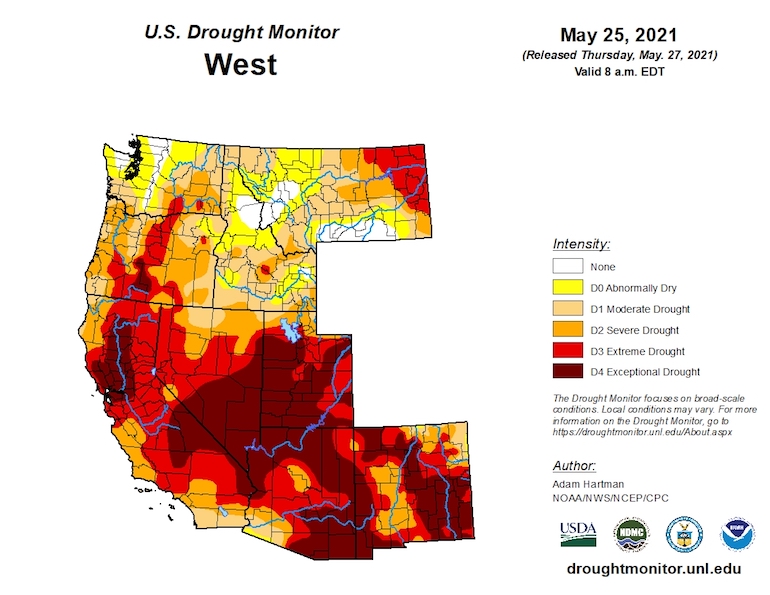
California and much of the western U.S. are entering a period of historic drought that experts say will stretch tight water supplies, increase wildfire risk, and bring new water-use restrictions — particularly for outdoor landscape use — as the summer unfolds.
Westlands Water District, which serves farms and rural communities on the west side of Fresno and Kings counties in CA, already announced a ban on outdoor landscape irrigation on May 26. Many other areas may soon follow suit.
Drought Conditions
Westlands’ move came in reaction to an announcement by the federal Bureau of Reclamation, which allocates water supply to the Central Valley Project (CVP), that it would be cutting its supply to municipal and industrial entities from 55% to 25%. Though the initial CVP water supply had been announced in February, conditions have degraded since then, according to the Bureau, with the Sacramento-San Joaquin River Basin currently at its driest since 1977. Between the April 1 and May 1 forecasts, there was a 685,000 acre-feet reduction in the projected natural flow to the Sacramento, Feather, Yuba, and American rivers.
According to The Mercury News, Sierra Nevada snowpack was just 59% of normal on April 1 — after the second dry winter in a row — and hot weather in May melted much of the snowpack significantly faster than was projected. “Due to the worsening drought conditions, inflow to our reservoirs was less than we expected,” Mary Lee Knecht, a Bureau spokeswoman told the newspaper. “Conditions are so dry, the water soaked into dry ground or it evaporated.”
A day previously, the Bureau had also announced fire restrictions in Arizona, southern Nevada, and southern California. It included bans on operating a motor vehicle or combustion engine equipment without a spark arrestor; smoking only in enclosed vehicles, and welding or operating an acetylene torch with open flames (except by permit). The Bureau cited increasingly high temperatures, low humidity, and dry vegetation. (For landscaping tips to reduce fire risk, click here.)
Use Restrictions
In Santa Clara County, the Valley Water District reacted to its “extreme drought” classification by calling for a voluntary reduction in water use from 20% to 25% in late April. “On average, more than 50% of water use in the average home takes place outdoors. Replacing your lawn with a water-efficient landscape can reduce your usage significantly. Our Landscape Rebate Program can help make the change,” said Board Chair Tony Estremera in a statement.
But calls for reducing water use may not be voluntary for much longer. Rick Callender, CEO of the SC Valley Water District, told The Mercury News, “We are truly in an emergency situation. We’re going to be seeking everything we can do to address this emergency. The public should expect tighter restrictions.”
The Mercury News further reported, “The district will consider which restrictions to put into place on June 8 at its next board meeting. They are likely to include limits on outdoor irrigation at homes and businesses, water cutbacks for golf courses and other areas, and additional measures seen during the 2012-16 drought and in prior drought emergencies dating back to the 1970s.”
Overall Picture
In an address last week, Elizabeth Klein, Senior Counselor, U.S. Department of the Interior told the Natural Resources Committee of the House of Representatives, “We have never seen drought at the scale and intensity that we see right now, and it is possible that this may be the baseline for the future.” She further reported:
- California is currently experiencing its third driest year on record; the second two driest years on record, and the driest year since 1977.
- In the Colorado River Basin, the years since 2000 has been the driest 22-year period in the Colorado River Basin in more than 100 years of record-keeping and one of the driest in the past 1,200 years according to data.
- The Pecos and Rio Grande Basins in New Mexico are entering their second consecutive year of extreme drought conditions in a cycle that has lasted more than two decades. Elephant Butte Reservoir, the largest reservoir in New Mexico, is expected to hit its lowest storage level since 1954 this year at 1% capacity.
- The Klamath Basin is experiencing one of the driest hydrologic years on record. Year-to-date precipitation is about 40% of average, and inflows to Upper Klamath Lake – the main water storage – are about 35% of average, the lowest on record. Oregon’s governor declared a drought emergency in the basin nearly two months ago.
“Each of these situations would be extremely difficult on its own, but they are coalescing together with severe drought conditions in several other basins like the Rio Grande and Pecos this year, and collectively, a very challenging water supply situation is unfolding in much of the west,” stated Klein. For the full statement, including measures being taken to address the long-term outlook, visit here.
In an effort to aid water conservation, many water districts offer incentives and rebates—particularly for low-water landscape conversions and irrigation equipment upgrades. For more on Santa Clara Valley Water District’s Landscape Rebate Program, visit here. Even if not seeking a rebate, these lists of low and very low water-use regional plants can be a helpful guide. A variety of other links for sustainable landscape design guides and templates can be found here. For xeriscaping tips as they apply to turf selection, click here.











![[VIDEO] Dickies®: Discover Workwear That’s Anything But Uniform](https://turfmagazine.com/wp-content/uploads/2023/06/1647663814-4b1a2a7742790a9b1e97a3b963477850192e1d6a9dfba9b07214a77bae25d6e3-d-218x150.jpg)






























![[VIDEO] Dickies®: Discover Workwear That’s Anything But Uniform](https://turfmagazine.com/wp-content/uploads/2023/06/1647663814-4b1a2a7742790a9b1e97a3b963477850192e1d6a9dfba9b07214a77bae25d6e3-d-324x160.jpg)